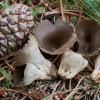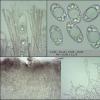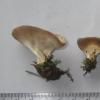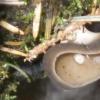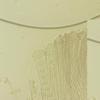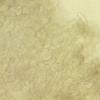
24-12-2025 17:08
Hulda Caroline HolteHello, I have found this propoloid ascomycete on

21-12-2025 09:32
Hello.A tiny ascomycete found embedded in wood in

21-12-2025 21:32
Pol DebaenstHello, Garden, Burgweg 19, Veurne, BelgiumOn 10/1

22-12-2025 23:38
Patrice TANCHAUDBonsoir, récolte sur un mur en pierre, apothéci

22-12-2025 00:47
Patrice TANCHAUDBonsoir, récolte à proximité du milieu dunaire
 Bonsoir,
Bonsoir,Sous Pinus uncinata, 1975 mts, jusqu'à 30 mm diamètre.
Croziers -
Amitiés.
The absence of croziers and the habitus of your Helvella seem to lead us to the clade leucomelaena. But I do not know how to distinguish Helvella leucomelaena from Helvella confusa, a species that I do not know. Maybe one of our colleagues could clarify these differences.
Good luck!
Enrique

Thank you for your contribution, I´m in the same situation as you, I await opinions.
Regards

the occurence under Pinus and the scalloped margin, it suggests H. leucomelaena, I think...
Is it possible that the soil is calcareous?
Greetings,
Marek

I don't know what kind of soil it is, sorry.
Regards
In my opinion, this is definitely H. leucomelaena, I do not know another of such features.
H. Confusa has a stem clearly ribbed and the goblets opens much earlier. Besides, H. Confus prefers places more damp.
greetings
Mirek

Hi All,
A few years ago I came across a Helvella on damp soil by the side of a small brook in Picea plantation close to limestone. To me, this seemed an unusual habitat for a Helvella and I expected a species new to me. Using the paper, Synopsis of the Saddle Fungi by Inger Skrede et al I arrived at H. confusa which is separated in the key from Leucomelaena in having a distinct stipe. I sent some photos to Inger who confirmed the ID as Dissingia confusa, separated from Helvella in being without croziers (see 'Pindara revisited.....', again by Inger Skrede et al). The specimens looked a bit paler than leucomelaena and were less stocky. Also they lacked a crenelated margin. I have come across leucomelaena and the habitat was totally different-on sand under Pinus in coastal plantation. My spore dimensions were 19-25x15-17, so close to Leandro's although the confusa spores are more broadly ellipsoid.
Best wishes,
Charles.


First of all, thank you very much for your opinions.
It's difficult to separate both species.
I find it hard to believe that a species that we found on the same beach could be the same as this at 2000 meters of altitude
Regards

In many cases the spores of D. leucomelaena have a certain parallelism in their lateral walls. Do you know if this is the same in D. confusa?


